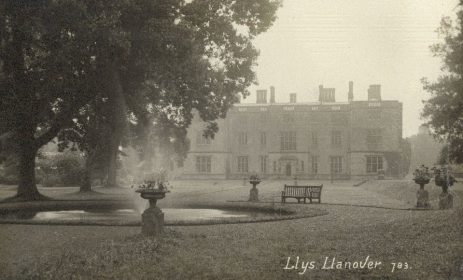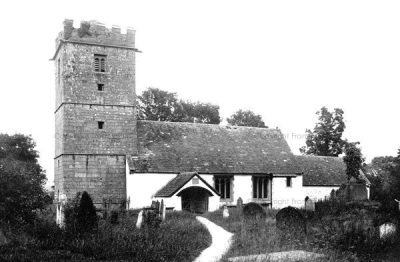Llanover Roots
phillips Family Llanover

After initially thinking our Phillips line began in St Brides, Wentloog, we were fascinated to find that in fact our Phillips family had originated in Llanover, with roots dating back to at last the mid 17th century. Llanover is a small village located four miles south of Abergavenny, the name derives from an earlier Welsh form Llanfyfor, made up of the words llan meaning ‘enclosure, church’ and the personal name Myfor.
The village of Llanover is a small collection of houses on the historic, privately-owned Llanover estate, which is associated with the Hall family. Augusta Lady Llanover lived locally during the 19th century and left her mark on the village and the surrounding estate which remains privately owned. Llanover House was demolished in 1936 but the park survives relatively intact and is designated Grade II on the Register of Parks and Gardens of Special Historic Interest in Wales.
We traced our Llanover roots back to our 5th great-grandfather, John Phillips, who was born in 1695. A baptism record shows he was baptised in the village of Llangattock-Vibon-Avel on 17th November 1695, whilst burial records tell us that he died in Llanover on 22nd April 1756. John was given the honour of being buried in the church and commemorated with a ledger stone. These are inscribed stone slabs laid into the floor of a church to commemorate or mark the place of the burial of an important deceased person.
We believe that John was honoured in this way due to his prominent role at the heart of the Llanover textile industry. He worked as a Dyer and was a landowner and employer. Dyeing is the application of dyes or pigments on textile materials such as fibres, yarns, and fabrics with the goal of achieving colour with desired colour fastness. In the 18th century, when John was working, the primary dyes were natural being extracted from plants or animals.


John raised a family in Llanover and amongst his children was our 4th great-grandfather, Phillip Phillips, born in 1718. Phillip followed his father as a Dyer and took over the business when his father died. We believe that the farm owned by the family was used to rear sheep for their wool. Our Llanover research proved particularly fruitful as we were also able to prove familial connections between the Llanover Phillips family and Sir Thomas Phillips, the former mayor of Newport. This substantiated a long-standing family story.
As the Phillips’ were a notable local family a number of important documents have survived, this made the research process much easier. These include a marriage certificate which shows that Phillip Phillips married Mary Daniel, the daughter of William Daniel in 1765. Mary was born in 1738 and baptised 5th November 1738. Mary was born in Llanfair Kilgeddin, a small village lying within the administrative community of Llanover.
We know that in 1778 Phillip was a landowner living in Llanover Lower, this information is included in the ‘History of Monmouthshire’ by Sir Joseph Alfred Bradney. Originally published between 1904 and the author’s death in 1933, this key reference work is essential for local history and genealogy in Monmouthshire. The book tells us that Phillip, along with other local landowners, had a responsibility to repair part of the church walls in Llanover and they worked on a strict rota basis to complete the task.
We believe that Phillip and Mary had a number of children, although to date we have only confirmed one birth record, that of our 3rd great-grandfather in 1775. He was named Philip Phillips after his father and was baptised locally on the 13th July 1775. Phillip may have had an elder sister named Gwenllian, who was baptised, to parents named Phillip and Mary Phillips, on 28th November 1765.


Mary died in 1807 and was buried on the 17th October at St Bartholomew’s Church in Llanover. She was followed by Phillip in 1810 who was buried with his father on 2nd June 1810, he was 93 years old. A death duty document for Phillip dated 9th October 1810 is held by the National Archives in Kew. The name of Phillip Phillips was added to his father’s ledger stone, as a permanent commemoration. The stone confirms his occupation as a Dyer and his date of death.
The Church of St Bartholomew is a historic church with its origins in the period following the Norman Conquest. The nave appears the earliest part of the present building, with the chancel dating from the 14th century. We visited the church in July 2024 whilst researching our Llanover roots.
Their son Phillip Phillips (b.1775) played a pivotal part in our family history. He married Ann Williams in 1807, and they went on to have four children whilst living in Llanover. They were Mary, Phillip (our second great-grandfather), John, and Thomas. They then decided to pursue new opportunities in St Brides, Wentloog on the Gwent Levels. Mary had been born in the village of St Brides and had a strong family network there.
The success of his family in Llanover allowed Phillip to buy the freehold of Greenmoor Farm, close to the centre of the village. They moved to St Brides around 1817 and he worked hard to establish himself locally, supported by his sons when they were older. Two further children followed, Jane 1820 and Mary 1822, making a family of eight. The family were recorded at Greenmoor on the first national census conducted in 1841.


Phillip enjoyed a long and successful life in Saint Brides and worked alongside his son Phillip well into his 80s. Although best known as a landowner in St Brides, an electoral register from 1849 shows that Phillip still owned the freehold of a farm in Llanover giving him the right to vote there. The property was leased to Richard Humphreys.
Like his father before him Phillip saw his 90th birthday, an event celebrated locally. Much of the later success of the Phillips family can be attributed to the work Phillip did in establishing Greenmoor Farm. Phillip died on 15th December 1866; he was 92. Shortly before his death Phillip had been invited to lay a stone for the new British school in St Brides, a task he was said to have completed with ease!
